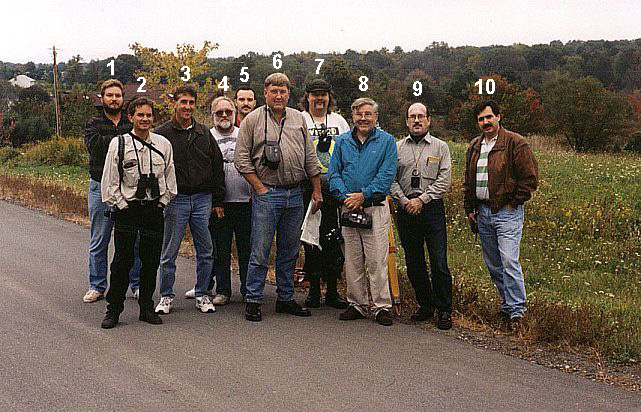
MUFON field crew, Muddy Kill Lane, Montgomery, NY, 3 October 1997
The Pine Bush Boomerang
Table of Contents
Video by Jim Bouck. Is it one of ours, or is it from elsewhere? You be the judge.
This video clip uses RealPlayer. If you don't see a RealPlayer control, you don't have the RealPlayer plug-in! It's available at www.real.com.
On the 3rd of October 1997 a group of people from four states gathered at Newburgh, NY, for a three day field trip. This was no ordinary group of people. They all belonged to MUFON, and came together to perform an experiment. They wanted to see if ten people could work together as one, and collect data at night using various types of instruments and cameras. They also wanted to try to duplicate some of the results of Bruce Cornet, who had been studying the Pine Bush phenomenon since June of 1992.

MUFON field crew, Muddy Kill Lane, Montgomery, NY, 3 October 1997
1. John Love
2. Dennis Hawley
3. Jim Durfee
4. Jim Bouck
5. Rick Atristain
6. Bruce Tilden
7. Bob Long
8. George Filer
9. Bruce Cornet
10. Alexander Zikas
11. Dick Stitts (not shown)
The team met and stayed at the Super 8 Motel in Newburgh, NY, and had an organizational meeting at a Holiday Inn nearby.
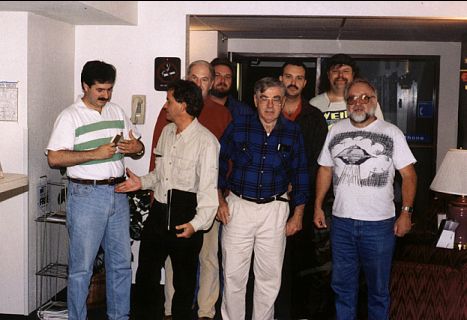
Rick Atristain organized the project, while Bruce Cornet provided the field locations for their nighttime experiment. The first location where the team set up their equipment was along Muddy Kill Lane, located on the eastern side of a low ridge along the western side of the Wallkill River Valley.
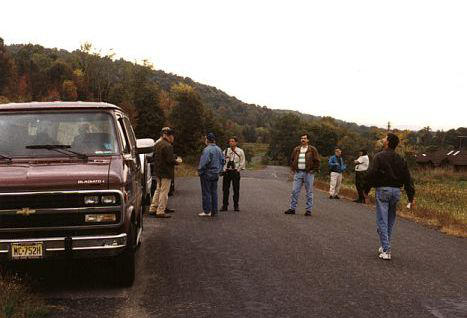
Two theodolites were used in order to track objects in the sky, determine their trajectories, triangulate their distances and altitudes, and record communications between pilots and the tower at Stewart International Airport. Rich Atristain gives members of the team a lesson in how to use the surveying equipment.
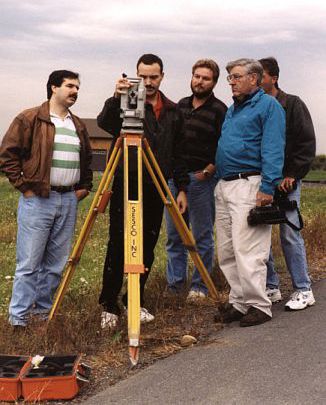
That location could not be maintained when local residents complained about our activities, and Montgomery police asked us to locate somewhere else. The police chief, Sergeant Edward Clancy, was kind enough to offer his property for us to conduct our experiment, but because it was not close to where Cornet had done his research, the Owen dairy farm was chosen instead.
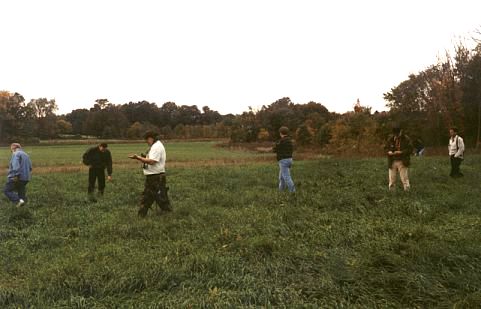
The team examines the Indian mound located on the Owen dairy farm at the center of the UFO hotspot. The aerial shot below, taken on 10 May 1994, shows the raised mound with remnant hexagonal shape, and another permanent circular feature to the west. It is from the small field just west of the circular feature that an AOP/UAP rose up two years earlier (see time exposures below). Circular discolorations in the grasses can still be seen from the air, years after they were made by craft landing and taking off from there.

The field between the mound and circle was measured, the theodolites set up and the distance between them measured, an cameras on tripods positioned in order to record aerial objects from different angles.
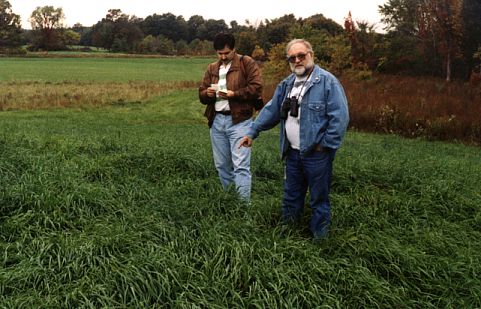
Jim Bouk points to a woodchuck hole on top of the Indian mound, while Alexander Zikas takes notes on the types of material brought to the surface by the woodchuck. That material consisted mostly of stream pebbles and orange-brown soil, implying that it was built up and not the product of natural erosion.
On 28 October 1995 another group of people witnessed an AOP (UAP of Dr. Richard F. Haines) turn on its plasma headlights, lift off from a small field to northwest of the Indian mound, and arc its way across the northern sky before descending to a field to the southeast of the mound. The craft took three minutes to reach its apogee before starting its descent.
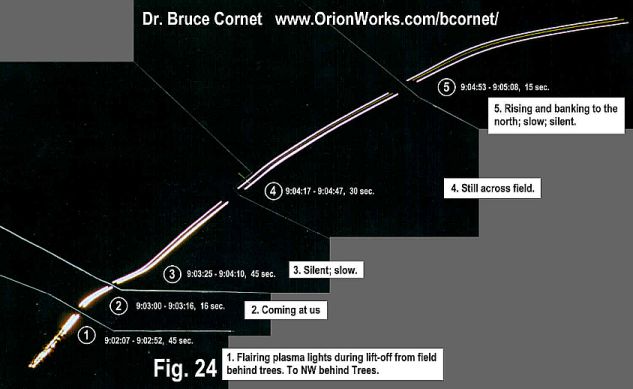
For most of the evening the team saw and recorded conventional aircraft either flying towards or from Stewart International Airport, or flying at high altitude over the valley. If it hadn't been for the recording of a pilot asking the control tower to "Check those runway lights up nice and bright for us," the sighting of an unusual aircraft might have peaked more curiosity. See Sound Analysis for a detailed explanation of what the spectrogram below shows.
It wasn't until Cornet had his film developed that he discovered the first two anomalies: Lights that appeared to strobe on the time exposures, but which did not strobe on the video, and glowing bars of light across the leading edges of both wings. In addition, the running lights on the video appear normal: White, green, and red. But all the lights on the time exposures are a golden color. None are white, green, or pure red. Seven still frames from the video are presented, showing the boomerang from directly below at 10:53:12 pm to showing it turning and moving away from the camera. 18 seconds of video are presented, with the last image at 10:53:30 pm viewing the boomerang from behind. The time exposure on the right represents about 20 seconds of time, with the central strobe firing once every three seconds.
See Image Analysis below.
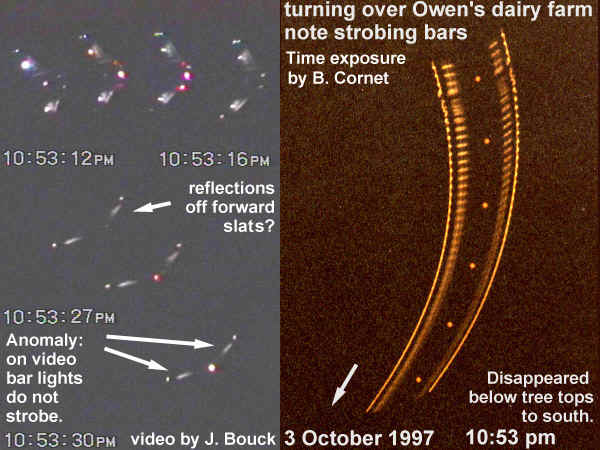
Whenever Cornet can get the help of commercial pilots and aircraft specialists in identifying aircraft, he presents them with his data. Bill Ristau analyzed the pictures above, and came back with the following comments.
----- Original Message -----
From: William E Ristau
To: bcornet@monmouth.com
Sent: Wednesday, September 12, 2001 7:07 PM
Subject: Re: Aircraft in litbeams.htmDr. Cornet, The pics of this wild looking "craft" appear to be what some observers call, the "Boomerang". The thing that caught my attention immediately, was the wing dihedral. It appears to portend an angle of 15 to 20 degrees or more. I do not remember ever flying any aircraft with more than about 5 to 7 degrees of dihedral. Dihedral enhances stability during turns. I'm guessing that this craft also has low speed capabilities, looking at your time exposed pic. This is speculation on my part, but the extreme angle of descent, not ending in a crash, might well be proof of that. It's another mystery ship, Bruce. I suppose it is one of ours (Its only money, right?).
As you well know, all airports are locked down now (since 9/11). Although I have credentials, they will not allow me to visit the ramp at Atlanta's Hartsville International Airport. The best that I can do, at this time, is to send you a site that will show a daytime pic of a DC-9. There are other airliners on the site. I think that all are daytime pics. Note that the leading edge slats are extended in this pic. The site address is as follows: http://www.airlinerphotos.com/picco/n8990e.jpg Am hoping that this pic and others might be helpful.
I have been a flight instructor and airline pilot for 31 years.
Take care, Bill Ristau.
There is no reflection of light off of a forward-projecting fuselage, and no reflection of light off of a tail section. If this aircraft had a tail and nose section, its bright lights would reflect off of some part of those structures. Compare the two images below:
There is no reflection of light off of engine pods. There is no elongate dark silhouette where a fuselage would be on a conventional aircraft. Instead, the fuselage appears to be trapezoid in shape, with a square, box-like front.
The running lights and strobes are asymmetrically positioned, which is highly unusual - especially for so many of them being asymmetrical. This condition is not typical of conventional aircraft. The landing lights and strobes are also located too close to the center line of the aircraft, something rarely seen for conventional aircraft. The image below is looking at the boomerang from directly below.
The colors of the strobes and running lights are off. This could be due in part to the CCD chip, and its inability to capture the correct color hues, but some of the colors are distinctly off hue for conventional aircraft lights. The green wingtip light is blue-green in color, while the red strobes flash orange-red and purple-red. Very similar anomalies and blue-colored lights were noted for a mantaray-shaped craft that Cornet caught on video flying sideways over his neighbor's property in Red Bank, NJ, on 24 April 1997. See Another Performance.
The dihedral angle of the wings is incorrect for a conventional aircraft. As Bill Ristau pointed out above, the dihedral angle of this aircraft is 15-20 degrees or more. NO conventional or military aircraft has its wings forming a V-shape like this - not even the B-2 stealth bomber, which has hardly any dihedral angle at all. The image below is looking at the boomerang from behind, not from directly below it. If this were the B-2 bomber, the apparent dihedral angle of the wings would have decreased to near zero in this picture.
The B-2 stealth bomber has hardly any dihedral angle, eliminating it as a possibility.
The time exposure shows all the lights to be of a similar golden color. Only the central bright light, which occasionally flashes red on the video, has an aura of red around it in the time exposure. The bar-like slats along the leading edge of the wings glow and pulse in time with the wingtip lights, something that is not seen in the video shots. Forward slats on conventional aircraft do not reflect light from nearby strobes, even though they are extended during landing. Thus, the question must be asked: Why does the video not agree with the time exposure? Why are the colors so different between the two media? Why do the two bright round lights in the center of each wing not show up very well on the time exposure (is this just a problem of orientation?), along with the other colored lights? In The Experiment, Cornet presents evidence that these types of anomalous craft can project different images to cameras positioned next to one another.
The sound produced by the boomerang-shaped aircraft resembles that of a conventional jetliner to the unaided ear. However, frequency spectral analysis reveals the very same types of characteristics noted for other anomalous craft caught on video and/or audio over the Pine Bush hotspot by Cornet between 1992 and 1997. The sound spectra are quite different from that of conventional aircraft jet engines in the following ways:
There is little or no white noise. White noise from jet engines typically ranges from 2 kHz up to 8 kHz, but the spectrogram of the boomerang shows no white noise and the highest frequencies reaching only 2.4 kHz. A frequency spectrogram for a commercial jetliner is shown below.
In addition, the frequencies of conventional jet engines tend to blend together to form gradational frequency changes. Although some frequency banding occurs, the frequencies are not divided into eight distinct frequency bands as they are for the boomerang.
The Pine Bush Boomerang has been reported by various people living in Orange and Ulster counties over the years. Ellen Crystall was one of the first people to report this type of craft in her book, Silent Invasion. She notes that boomerangs come in small and large varieties (Crystall, 1991, p. 115). The small one is described as being about 25 feet from tip to tip, while the large one appears to be about 200 feet in perimeter. What we witnessed at the Owen dairy farm on 3 October 1997 matches her description of the larger craft.
The asymmetrical distribution of strobes and lights (for example, the large white central light is positioned slightly off to the starboard side of dead center, and the two red strobes are not in line with one another), as well as the blue-green color of the "green" starboard light, are characteristics of these anomalous craft.
For example, on 10 July 1992 the Manta Ray flew over Cornet on South Searsville Rd., Montgomery, NY (Figure 7). Cornet ran out of film. The Manta Ray stopped and hovered, waiting for Cornet to put in a new roll of film. The next pictures he got of the diamond-shaped craft flying overhead show multicolored asymmetrically-positioned lights. Either that or the craft was flying rotated at an angle.
The absence of white noise and the composite nature of the frequency spectrum for its engine sound indicate that the sound recorded is probably synthetic and not mechanical. Similar synthetic sounds have been recorded for other Pine Bush AOP/UAP.
- The recording of a pilot asking the control tower to turn up the runway lights, and then thanking the tower for complying, strongly implicates a human pilot and a possible military aircraft landing at Stewart Air Force Base. However, there has been strong evidence for mimicry. See Mimicry may be the Objective of ETI Triangular and Diamond-shaped Probes. It would not be out of consideration that this boomerang intentionally flew over us when an aircraft was on approach to Stewart. The broadcast of a request to the control tower would be coincidental, giving the boomerang a great cover. Such timing has been a common ploy used in the past, but uncovered when the type of aircraft that landed did not match what was witnessed in the field.
- Bruce Tilden was stationed at Stewart International Airport, photographing and recording all the aircraft that landed and took off during the time the other members of the team made observations at the Owen dairy farm. Unfortunately, he remained there only until about 8:30 pm, and did not see any aircraft landing at the time the boomerang would have landed.
- If he had remained at Stewart, his data might show that the boomerang landed at Stewart airport, solving one mystery.
This web page was last updated on 11/10/2021
Copyright B.Cornet 2001